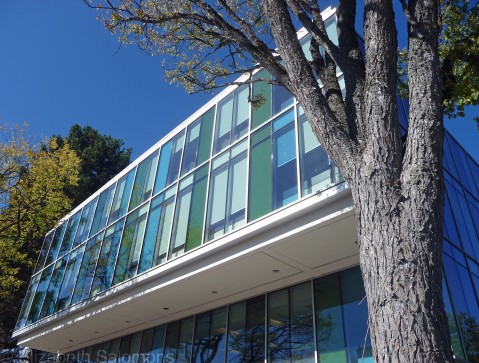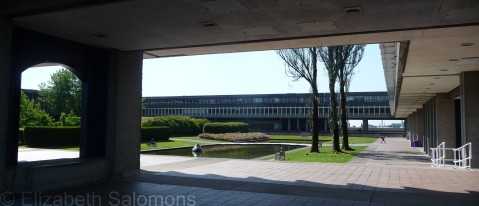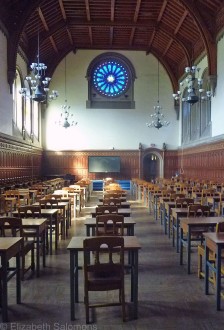Through My Lens: Nitobe Memorial Garden in the Fall

More than a year ago, I posted a photo of Nitobe Memorial Garden in all its spring glory.
Here it is in the fall. Glory.
The Chan Centre
When I was blogging about spectacular European opera houses last spring, it occurred to me that spectacular Canadian opera houses are few and far between.
No matter. We do have some spectacular concert halls.
This is a photo of the Chan Centre. Located on the Point Grey campus of the University of British Columbia, it was designed by the Vancouver-based architect Bing Thom. Its main concert hall is shaped like a cello and the acoustics are state of the art.
This time of year, the Chan looks particularly spectacular.

University of British Columbia
The last school I want to show you on my tour of schools I’ve photographed is the University of British Columbia. Like Simon Fraser University, UBC is situated a ways away from the hustle and bustle of the city centre ― its main campus is located at the western tip of Point Grey, a peninsula to the west of Vancouver’s toniest neighbourhoods.
UBC is a hodge-podge of architectural styles. For one, it’s got your neo-Gothic. This is the Chemistry Building, one of the first three buildings constructed on the Point Grey campus. That was back in 1925.

For another, it’s got your Brutalism. The Buchanan Tower was built in 1972.

And it’s got your postmodernism. This is the Koerner Library, which was designed by Arthur Erickson and completed in 1997.

UBC is fond of combining architectural styles when it builds additions to existing buildings. The Main Library, another of the three buildings constructed in 1925, morphed into the Irving K. Barber Learning Centre in 2008. The neo-Gothic centre is the original building, now surrounded by a postmodern glass structure.

Here’s a look at it from another angle.

Four wings were added to the Chemistry Building between 1959 and 1989. This is a corner of one of those wings, built in the Brutalist style.

And this postmodern structure is an addition to the Henry Angus Building, which houses the Sauder School of Business. The addition, which opened in 2012, is wrapped around the original building, which was built in 1965 and expanded in 1976.

With 50,000 students, UBC is Canada’s fourth largest university and the largest in Western Canada. These days, the Point Grey campus is one massive construction site. In the past year, work was completed on a new trolley bus loop, upgrades to primary pedestrian corridors (which for some reason I have yet to figure out are called “malls” here), and a new fountain in Martha Piper Plaza. Building construction currently underway includes a new Student Union Building, the new Centre for Brain Health at UBC Hospital, and expansion of the UBC Bookstore. A new building that will house the Faculty of Education is scheduled to break ground this winter.
UBC’s Class of 2016 fittingly calls itself the Class of Construction.
Simon Fraser University
And now, for something completely different.

Unlike the universities I wrote about in the previous four posts, whose campuses are all situated smack in the middle of a city, Simon Fraser University sits above the city, on top of a mountain. (Which, in my humble opinion, takes the notion of an Ivory Tower a tad too literally.)

Construction of SFU’s Burnaby campus was begun in the spring of 1964, and the university welcomed its first 2500 students in September 1965.

The architects were Arthur Erickson ― probably Vancouver’s best-known and most influential architect ― and Geoffrey Massey. The campus atop Burnaby Mountain is in the Brutalist style of architecture, and won the 2007 Prix du XXe siècle from the Royal Architectural Institute of Canada, which recognizes buildings of significance to Canada’s architectural history.

University of Cambridge

I went to Cambridge for one reason and one reason only: to hear the King’s College Choir.
I got to hear them sing a Choral Eucharist service in this chapel, the King’s College Chapel of King’s College of the University of Cambridge. Quite the chapel. Quite the choir.
I don’t remember much else of the University of Cambridge or the city of Cambridge. It was a quick one-night stop at the end of a three-week English walkabout and I was weary of sight-seeing.
But I’m never weary of choral music. It was worth the stop.
University of Oxford
When I applied to and was accepted at the University of Toronto, I enrolled as a student at Woodsworth College. I didn’t get the whole college-thing they had going at U of T, and didn’t much care what college they stuck me in, but eventually I discovered that all unclassified and part-time students (I was both) were lumped together at Woodsworth.
When I would introduce myself to my fellow undergrads, the first question after “What’s your major?” was always: “What college are you?” I quickly figured out that each college at U of T had its own personality, and prestige, and Woodsworth didn’t rank very high with respect to either.
This all seemed rather strange and unusual to me. In Western Canada, you applied to and enrolled in a faculty; in my case, I was a student in the Faculty of Arts at the University of Alberta. Colleges were independent entities, completely separate from the universities; I had attended one of those as well before transferring to U of A.
Like I said, I didn’t “get” the whole college-thing they had going at U of T.
Until I got to Oxford, that is.

Oxford is chockfull of colleges ― 38 of them, in fact ― and as I wandered around the “city of dreaming spires,” I came to the realization that the University of Toronto is modelled after the University of Oxford. So that’s where U of T got the idea for all those colleges, I said to myself.
Many of the colleges of Oxford University are open to the public, and I walked reverently through several of them. I happened to walk by the entrance to the chapel of Magdalen College (where C.S. Lewis taught) and was warmly invited to attend the Choral Evensong service that was about to begin. In the Great Hall of Christ Church College, I was greeted by an elderly gent whose sole job seemed to be pointing out the “Alice” window to visitors. (That would be the stained glass window put in to commemorate the author Lewis Carroll, who had been a Christ Church scholar.)
Oxford is a beautiful town. I explored it while on walkabout in the English countryside some years ago, fell in love with it, and made a promise to one day return to it.
University of Toronto
Next up on my tour of schools I’ve photographed: the University of Toronto. I was a student here myself a long time ago, just for a year, and to this day I consider it the prettiest of all the schools I’ve attended (and there’ve been a few).
When I commented to my sister on the architectural style of the buildings at Johns Hopkins, she asked me what the buildings at U of T looked like.
“They’re neo-Gothic,” I said. Also called Gothic Revival, you see neo-Gothic buildings all over Canada ― our Parliament Buildings in Ottawa are probably the best-known example.
The University of Toronto has been around since 1827, has a dozen colleges on three campuses, and is the largest university in Canada with an enrollment of 75,000 students. I took these photos of the St. George campus when I was in Toronto exactly a year ago this week.
Not all of the buildings on the St. George campus are neo-Gothic. The main building of Victoria University, shown below, is called Richardsonian Romanesque, after its architect, Henry Hobson Richardson.

Trinity College is in the Jacobethan style.

And this monstrosity, Robarts Library, was built in the 1970s in what is known as Brutalist Architecture. Appropriate name for the look, I should think. It’s not-so-affectionately known as “the Turkey” by the students of U of T; I’m sure you can figure out why.

Johns Hopkins University
Working on a university campus ― as I now do ― I’m much more in tune to the rhythms of the academic year than I have been for a long, long time. UBC has been delightfully (delightfully!) deserted these past four months, but then, all of a sudden, all at once, more than 50,000 students descended onto the campus this past week, and the place is now overrun (overrun!) with twentysomethings.
On my travels, I sometimes find myself wandering around university campuses. The architecture always fascinates me, as each school has its own unique look. And so, this being September, I thought I would take you on a tour of some of the schools I’ve photographed.
First up: Johns Hopkins University. It’s not the biggest of schools ― about 20,000 students ― but it certainly is a reputable school. I was shown around its Homewood campus by my sister just over a year ago, when I was in Baltimore to visit her.

Hopkins was founded in 1876 through a bequest by Baltimore abolitionist, entrepreneur, and philanthropist Johns Hopkins. Here is a bust of the man himself.

Homewood House, seen in the next photo, was a private home built around 1800 that was eventually given to the university. It was built in the Federal Style ― a style of architecture you don’t see much in Canada ― and is said to be the inspiration for the look of the Homewood campus of JHU. It’s now a museum.

This is Gilman Hall, home to the humanities and social sciences departments.

And this is what you see once you step inside Gilman Hall.

Keep on walking, and you’ll come to the Hutzler Reading Room.

It is such a beautiful room I couldn’t stop taking photos. Here’s another.

And another.

The imposing structure shown below is the Milton S. Eisenhower Library. As impressive as it is, it’s not quite as impressive as the George Peabody Library, located at the Peabody campus of JHU, which my sister took me to see after our tour of the Homewood campus. (Click here to see a photo of that library.)

On another day, while waiting for a bus, I realized we were standing in front the Johns Hopkins Hospital, so I took this photo. I quite like the three-storeyed porch, which I didn’t notice until I was editing these photos. Johns Hopkins Hospital is the top-rated hospital in the United States, and its School of Medicine is located on the East Baltimore campus of JHU.

So there it is: your look at Johns Hopkins University. My one regret is I didn’t get to see it in its fall glory, which I’m sure must be spectacular.

Through My Lens: Lunch Break

Last summer, these delightful giant pillows lay on Robson Street, directly in front of the Vancouver Art Gallery. This summer, they found a new home in front of UBC’s Koerner Library. They’re called Pop Rocks. Their fabric was recycled from the old sails at Canada Place (which were replaced in 2010), and they were stitched together by a local sail maker.
I wonder how many lunch-time naps they’ve witnessed?
Through My Lens: Nitobe Memorial Garden

I took this photo last Friday in the beautiful Nitobe Memorial Garden. This garden is located at the opposite corner of the UBC campus from my office ― which makes for a nice walk when I’m on my lunch break. As I’ve noted before, I think UBC is a beautiful campus. The Nitobe Memorial Garden only reaffirms my belief.








